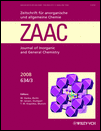Strukturen von polaren Magnesiumorganylen: Synthese und Struktur von Basen-Addukten des Bis(cyclopentadienyl)magnesiums
Abstract
Structures of Polar Magnesium Organyls: Synthesis and Structure of Base Adducts of Bis(cyclopentadienyl)magnesium
Eight donor-acceptor complexes of bis(cyclopentadienyl)magnesium (1) with N- and O-donor Lewis bases have been synthesized and characterized by X-ray structure analysis. With acetonitrile, dimethoxyethane, diethyleneglycoldimethylether, dioxane, and tetramethylethylenediamine simple 1:1 adducts are formed (2–6). In some cases a change of the hapticity of one cyclopentadienylring from η5 to η2 or η1 is observed (4–6). In the adduct with pentamethyldiethylenetriamine (7) one C5H5-ring is removed from the magnesium atom forming the cation [Mg(C5H5)(PMDTA)]+ and an uncoordinated five-ring anion. With the crown ether 15-crown-5 the two ionic Mg compounds 8 and 9 are formed which have a [Mg(15-crown-5)L2]2+-cation [L = pyridine, THF] and two uncoordinated cyclopentadienyl anions. Cyclopentadienyl-methyl-magnesium reacts with 15-crown-5 to the salt [Mg(CH3)(15-crown-5)]+ C5H5− (10) which has also a free cyclopentadienyl anion.




